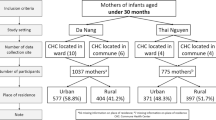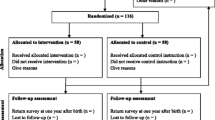Abstract
Using data from a longitudinal study of breastfeeding in Hispanics, this study evaluated the influence of early skin-to-skin contact (SSC) on initiation and sustained exclusive breastfeeding (EBF) at 1 month postpartum. Two-thirds of the women in the sample participated in early SSC. At discharge, over half of the women were EBF; this proportion decreased to one-third at 1 month postpartum. Controlling for demographic and clinical variables in the model, participation in early SSC was associated with a greater than sevenfold increase in the odds of EBF at discharge (p = .005) but was not predictive of EBF at 1 month post-discharge (p = .7). Younger maternal age and increased prenatal infant feeding intention were associated with an increased likelihood of EBF across both timepoints. Promoting early SSC may help with initiation of EBF, while further breastfeeding support may be needed to maintain EBF following discharge for this vulnerable population.

Similar content being viewed by others
References
World Health Organization. Nutrition Exclusive Breastfeeding. 2012. Cited 2012 December. http://www.who.int/nutrition/topics/exclusive_breastfeeding/en/.
American Academy of Pediatrics. Breastfeeding and the use of human milk. Pediatrics. 2012;129(3):e827–41.
United States Breastfeeding Committee. Breastfeeding saves billions. 2011. http://www.usbreastfeeding.org/LinkClick.aspx?link=Publications%2fHealth-Care-Reform-One-Page-USBC-update.pdf&tabid=70&mid=388.
Metzger MW, McDade TW. Breastfeeding as obesity prevention in the United States: a sibling difference model. Am J Hum Biol. 2010;22(3):291–6.
Spatz DL. Preventing obesity starts with breastfeeding. J Perinat Neonatal Nurs. 2014;28(1):41–50.
Parikh NI, et al. Breastfeeding in infancy and adult cardiovascular disease risk factors. Am J Med. 2009;122(7):656-63.e1.
Ogden CL, et al. Prevalence of childhood and adult obesity in the united states, 2011–2012. JAMA. 2014;311(8):806–14.
Cartagena DC, et al. Factors contributing to infant overfeeding with Hispanic mothers. J Obstet Gynecol Neonatal Nurs. 2014;43(2):139–59.
Centers for Disease Control and Prevention. Final Formula supplementation of breast milk rates by socio-demographic factors, among children born in 2006. 2012. Cited 2012 08/15/2012. http://www.cdc.gov/breastfeeding/data/NIS_data/2006/socio-demographic_formula.htm.
Bartick M, Reyes C. Las dos cosas: an analysis of attitudes of latina women on non-exclusive breastfeeding. Breastfeed Med. 2012;7(1):19–24.
Gill SL. Breastfeeding by Hispanic women. J Obstet Gynecol Neonatal Nurs. 2009;38(2):244–52.
Nommsen-Rivers LA, et al. Comfort with the idea of formula feeding helps explain ethnic disparity in breastfeeding intentions among expectant first-time mothers. Breastfeed Med. 2010;5(1):25–33.
Chapman DJ, Perez-Escamilla R. Breastfeeding among minority women: moving from risk factors to interventions. Adv Nutr. 2012;3(1):95–104.
Wambach K, Riordan J. Breastfeeding and human lactation. 5th ed. Jones & Bartlett Learning: Burlington; 2014. p. 966.
UNICEF. Baby friendly initiative standards. Step_4_implementation: skin-to-skin contact after delivery. 2014. http://www.unicef.org.uk/Documents/Baby_Friendly/Guidance/Implementation%20Guidance/Step_4_Implementation.pdf.
Ludington-Hoe S. Skin-to-skin contact: a comforting place with comfort food. Am J Mater Child Nurs. 2015;40(6):359–66.
Holmes AV, McLeod AY, Bunik M. ABM Clinical Protocol #5: peripartum breastfeeding management for the healthy mother and infant at term, revision 2013. Breastfeed Med. 2013;8(6):469–73.
Moore ER, et al. Early skin-to-skin contact for mothers and their healthy newborn infants. Cochrane Database Syst Rev. 2012;5:CD003519.
Bigelow A, et al. Effect of mother/infant skin-to-skin contact on postpartum depressive symptoms and maternal physiological stress. J Obstet Gynecol Neonatal Nurs. 2012;41(3):369–82.
Okan F, et al. Analgesic effects of skin-to-skin contact and breastfeeding in procedural pain in healthy term neonates. Ann Trop Paediatr. 2010;30(2):119–28.
Srivastava S, et al. Effect of very early skin to skin contact on success at breastfeeding and preventing early hypothermia in neonates. Indian J Public Health. 2014;58(1):22–6.
International Lactation Consultant Association. Clinical guidelines for the establishment of exclusive breastfeeding. US: ILCA; 2014.
Varendi H, Porter RH. Breast odour as the only maternal stimulus elicits crawling towards the odour source. Acta Paediatr. 2001;90(4):372–5.
Varendi H, Porter RH, Winberg J. Does the newborn baby find the nipple by smell? Lancet. 1994;344(8928):989–90.
Porter RH. The biological significance of skin-to-skin contact and maternal odours. Acta Paediatr. 2004;93(12):1560–2.
Redshaw M, Hennegan J, Kruske S. Holding the baby: early mother–infant contact after childbirth and outcomes. Midwifery. 2014;30(5):e177–87.
Bramson L, et al. Effect of early skin-to-skin mother–infant contact during the first 3 hours following birth on exclusive breastfeeding during the maternity hospital stay. J Hum Lact. 2010;26(2):130–7.
Linares AM, et al. Factors influencing exclusive breastfeeding at 4 months postpartum in a sample of urban Hispanic mothers in Kentucky. J Hum Lact. 2015;31(2):307–14.
University of Kentucky. Standard operational procedures: informed consent. Lexington, KY: University of Kentucky; 2013.
Nommsen-Rivers LA, Dewey KG. Development and validation of the infant feeding intentions scale. Matern Child Health J. 2009;13(3):334–42.
Nommsen-Rivers LA, et al. The Infant Feeding Intentions scale demonstrates construct validity and comparability in quantifying maternal breastfeeding intentions across multiple ethnic groups. Matern Child Nutr. 2010;6(3):220–7.
Liang K-Y, Zeger SL. Longitudinal data analysis using generalized linear models. Biometrika. 1986;73(1):13–22.
Stevens J, et al. Immediate or early skin-to-skin contact after a Caesarean section: a review of the literature. Matern Child Nutr. 2014;10(4):456–73.
Petrova A, Hegyi T, Mehta R. Maternal race/ethnicity and one-month exclusive breastfeeding in association with the in-hospital feeding modality. Breastfeed Med. 2007;2(2):92–8.
Anderson LM, et al. Culturally competent healthcare systems: a systematic review. Am J Prevent Med. 2003;24(3 Suppl):68–79.
Juckett G. Caring for Latino patients. Am Fam Physician. 2013;87(1):48–54.
Faraz A. Clinical recommendations for promoting breastfeeding among Hispanic women. J Am Acad Nurse Pract. 2010;22(6):292–9.
Hernandez IF. Promoting exclusive breastfeeding for Hispanic women. MCN Am J Mater Child Nurs. 2006;31(5):318–24.
Center for Disease Control and Prevention. Preventing obesity begins in hospitals. Atlanta: Center for Disease Control and Prevention; 2011.
Kitano N, et al. Combined effects of maternal age and parity on successful initiation of exclusive breastfeeding. Prev Med Rep. 2016;3:121–6.
Acknowledgments
We thank Maria Gomez, Dr. PH, and Ana Machado, MPH, for their valuable collaboration in the data collection process.
Funding
This research was funded by the Start Fund of College of Nursing, University of Kentucky, assigned to the first author. Additionally, the project described was supported by the National Center for Research Resources and the National Center for Advancing Translational Sciences, National Institutes of Health, through Grant 8UL1TR000117-02. The content is solely the responsibility of the authors and does not necessarily represent the official views of the NIH”.
Author information
Authors and Affiliations
Corresponding author
Ethics declarations
Conflicting Interests
The authors declared no potential conflicts of interest with respect to the research, authorship, and/or publication of this article.
Rights and permissions
About this article
Cite this article
Linares, A.M., Wambach, K., Rayens, M.K. et al. Modeling the Influence of Early Skin-to-Skin Contact on Exclusive Breastfeeding in a Sample of Hispanic Immigrant Women. J Immigrant Minority Health 19, 1027–1034 (2017). https://doi.org/10.1007/s10903-016-0380-8
Published:
Issue Date:
DOI: https://doi.org/10.1007/s10903-016-0380-8




